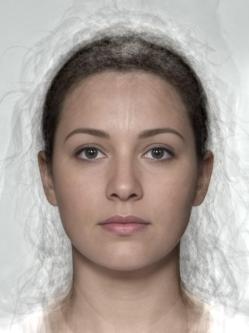No Science Behind the Story

Earlier this week, Christine Caldwell wrote about the lack of scientific evidence behind a Daily Mail story about killer cats, warning readers to be particularly skeptical of scientific claims in news articles that fail to link to primary sources. It may just be a coincidence, but one of the most popular articles at the Mail Online this past week, titled “Meet the world’s Mrs Averages: Scientists blend thousands of faces together to reveal what the typical woman’s face looks like in 41 different countries from around the globe“, also had no basis in actual science, amounting to little more than a game of broken telephone.
I was first alerted to this story by an automated Google alert telling me that traffic on my website had increased by several hundred percent. Most of the traffic was coming from the Daily Mail website, so I had a look at the source. Imagine my surprise when I found an article about completely unfamiliar ‘research’ allegedly coming out of my own lab.
What did the media say?
The article showed images of average faces from 41 different countries. The images were described as being part of a study by “experimental psychologists at the University of Glasgow”, although specific details about the hypothesis of the research, the names of the researchers involved, the title of the paper describing the study, or the name of the journal in which it was published were absent. Similarly unattributed criticisms of the research were also discussed. Surprisingly, given that no one allegedly involved spoke to any reporters, the article includes a rebuttal to these criticisms:
Those behind the project say that many of the criticisms are explained by the process.
What’s the real story?
In actuality, these images were created as part of an art project by Colin Spears and posted on his website more than two years ago. My lab was tangentially involved in that Mr Spears used the free online face averager on my lab’s website, but we had no other involvement in the project whatsoever.
So where did all this misinformation come from?
A bit of internet sleuthing revealed that a recent article on the photography blog Fstoppers attributed the image to my lab, citing their image source as a page at 9gag that simply shows the image with no attributing text. However, both the Fstoppers and 9gag images had a 9gag watermark, but the Daily Mail images did not. Further digging turned up a post from 2011 on Jezebel that mistakenly attributed the images to my lab (back when we were at the University of Aberdeen) and that includes a prominent response by the actual creator of the images. Jezebel attributes the source of their post as an article on Mashable that correctly credits my lab as only providing the software used to make the images, but still does not mention the original creator. They cite Photoxels as their source, who cite Reddit. The very top comment on the Reddit article is a link to Colin Spears’ website. Within half an hour of investigation, I was able to confirm the original source of the image, and confirm that this story did not have a scientific basis.
Bizarrely, a Google image search of the images from the Daily Mail led me to another Daily Mail article, this one published in 2011 and titled “Meet Miss Average from around the world as computer works out the most common face in each country“, where neither Colin Spears nor my lab are mentioned, but the same images (cropped differently) are attributed to Mike Mike, the creator of the Face of Tomorrow project. Both the 2011 article and the current one include this identical text:
The 46-year-old got the idea for his project when he was studying at London’s Goldsmiths College.
He said: ‘Sitting on the underground train, I was intrigued by the sheer diversity of the place – Somalis, Indians, Americans, Zimbabweans, Scandinavians and a hundred other nationalities vying for their place in the metropolis.
‘I thought: “What is this place, what is a Londoner?”
What can be done?
Although my own attempts at contacting the writer of the Daily Mail article led nowhere, the press officer at my university succeeded in getting part of the article changed so the the image was no longer explicitly described as research coming out of an experimental psychology lab at the University of Glasgow. However, as of today, the title still contains “Scientists blend thousands of faces…”. Unfortunately, the story has already been shared on social networks and blogs thousands of times, so I am grateful that it is only a case of mistaking an art project for a scientific study rather than mistaking dangerous medical advice for evidence-based scientific recommendations.
So what can readers do to avoid being duped by news stories with no basis in fact? My best advice is to always look for a link to the original source. You can start by contacting us with questions about new stories by replying to stories here at our blog or tweeting us at @ResTheHeadlines. Sense About Science also has a great project titled Ask for Evidence.
From → News Stories, Psychology, Science or Fiction


Trackbacks & Pingbacks